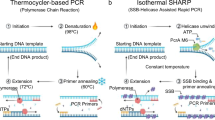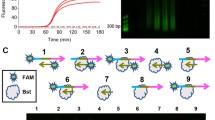Abstract
Various abnormal phenomena have been observed during PCR so far. The present study performed a series of consecutive PCRs (including many rounds of re-amplification continuously) and found that the abortion of re-amplification was inevitable as long as a variety of complicated product appeared. The aborting stages varied, according to the lengths of targets. Longer targets reached the abortion earlier than the shorter ones, marked by appearance of the complex that was immobile in electrophoresis. Denatured gel-electrophoresis revealed that the complex was mainly made up of shorter or partially synthesized strands, together with small amounts of full-length ones. Able to be digested by S1 nuclease but unable by restriction endonucleases (REs), the complex was proved to consist of both single regions and double-helix regions that kept the complex stable thermodynamically. Simulations gave evidence that partial strands, even at lower concentration, could disturb re-amplification effectively and lead to the abortion of re-amplifications finally. It was pointed out that the partial strands formed chiefly via polymerase’s infidelity, and hence the solution to lighten the abnormality was also proposed.
Similar content being viewed by others
References
Erlich H A, Gelfand D, Sninsky J J. Recent advances in the polymerase chain reaction. Science, 1991, 252: 1643–1651
Keohavong P, Thilly W G. Fidelity of DNA polymerases in DNA amplification. Proc Natl Acad Sci USA, 1989, 86: 9253–9257
Mutter G L, Boynton K A. PCR bias in amplification of androgen receptor alleles, A trinucleotide repeat marker used in clonality studies. Nucleic Acids Res, 1995, 23: 1411–1418
Jansen R, Ledley F D. Disruption of phase during PCR amplification and cloning of heterozygous target sequences. Nucleic Acids Res, 1990, 18: 5153–5156
Meyerhans A, Vartanian J P, Wain-Hobson S. DNA recombination during PCR. Nucleic Acids Res, 1990, 18: 1687–1691
Kunkel T A. Frameshift mutagenesis by eucaryotic DNA polymerases in vitro. J Biol Chem, 1986, 261: 13581–13587
Paabo S, Irwin D M, Wilson A C. DNA damage promotes jumping between templates during enzymatic amplification. J Biol Chem, 1990, 265: 4718–47
Cheng S, Fockler C, Barnes W M, et al. Effective amplification of long targets from cloned inserts and human genomic DNA. Proc Natl Acad Sci USA, 1994, 91: 5695–5699
Thiel V, Rashtchian A, Herold J, et al. Effective amplification of 20-kb DNA by reverse transcription PCR. Anal Biochem, 1997, 252: 62–70
Hengen P N. Reamplification of PCR fragments. Trends Biochem Sci, 1995, 20: 124–125
Bonnet S, Prevot G, Bourgouin C. Efficient reamplification of differential display products by transient ligation and thermal asymmetric PCR. Nucleic Acids Res, 1998, 26: 1130–1131
Frost M R, Guggenheim J A. Prevention of depurination during elution facilitates the reamplification of DNA from differential display gels. Nucleic Acids Res, 1999, 27: 1386–1391
Bell D A, DeMarini D M. Excessive cycling converts PCR products to random-length higher molecular weight fragments. Nucleic Acids Res, 1991, 19: 5079
Sambrook J, Russell D W. Molecular Cloning: A Laboratory Manual. 2nd ed. New York: Cold Spring Harbor Laboratory Press, 1995
Olsen D B, Eckstein F. Incomplete primer extension during in vitro DNA amplification catalyzed by Taq polymerase; exploitation for DNA sequencing. Nucleic Acids Res, 1989, 17: 9613–9620
Marton A, Delbecchi L, Bourgaux P. DNA nicking favors PCR recombination. Nucleic Acids Res, 1991, 19: 2423–2426
Huang M M, Arnheim N, Goodman M F. Extension of base mispairs by Taq DNA polymerase: Implications for single nucleotide discrimination in PCR. Nucleic Acids Res, 1992, 20: 4567–4573
Bambara R A, Fay P J, Mallaber L M. Methods of analyzing processivity. Methods Enzymol, 1995, 262: 270–280
Odelberg S J, Weiss R B, Hata A, et al. Template-switching during DNA synthesis by Thermus aquaticus DNA polymerase I. Nucleic Acids Res, 1995, 23: 2049–2057
Wang G C, Wang Y. Frequency of formation of chimeric molecules as a consequence of PCR coamplification of 16S rRNA genes from mixed bacterial genomes. Appl Environ Microbiol, 1997, 63: 4645–4650
Bradley R D, Hillis D M. Recombinant DNA sequences generated by PCR amplification. Mol Biol Evol, 1997, 14: 592–593
Judo M S, Wedel A B, Wilson C. Stimulation and suppression of PCR-mediated recombination. Nucleic Acids Res, 1998, 26: 1819–1825
Zaphiropoulos P G. Nonhomologous recombination mediated by Thermus aquaticus DNA polymerase I. Evidence supporting a copy choice mechanism. Nucleic Acids Res, 1998, 26: 2843–2848
Cronn R, Cedroni M, Haselkorn T, et al. PCR-mediated recombination in amplification products derived from polyploid cotton. Theor Appl Genet, 2002, 104: 482–489
Hamilton S C, Farchaus J W, Davis M C. DNA polymerases as engines for biotechnology. Biotechniques, 2001, 31: 370–376, 378–380, 382–373
Kelman Z, Hurwitz J, O’Donnell M. Processivity of DNA polymerases: two mechanisms, one goal. Structure, 1998, 6: 121–125
Kornberg A. Ten commandments: lessons from the enzymology of DNA replication. J Bacteriol, 2000, 182: 3613–3618
Fromenty B, Demeilliers C, Mansouri A, et al Escherichia coli exonuclease III enhances long PCR amplification of damaged DNA templates. Nucleic Acids Res, 2000, 28: e50
Bullard J M, Williams J C, Acker W K, et al. DNA polymerase III holoenzyme from Thermus thermophilus identification, expression, purification of components, and use to reconstitute a processive replicase. J Biol Chem, 2002, 277: 13401–13408
Davidson J F, Fox R, Harris D D, et al. Insertion of the T3 DNA polymerase thioredoxin binding domain enhances the processivity and fidelity of Taq DNA polymerase. Nucleic Acids Res, 2003, 31: 4702–4709
Wang Y, Prosen D E, Mei L, et al. A novel strategy to engineer DNA polymerases for enhanced processivity and improved performance in vitro. Nucleic Acids Res, 2004, 32: 1197–1207
Kainz P, Schmiedlechner A, Strack H B. Specificity-enhanced hot-start PCR: addition of double-stranded DNA fragments adapted to the annealing temperature. Biotechniques, 2000, 28: 278–282
Lin Y, Jayasena S D. Inhibition of multiple thermostable DNA polymerases by a heterodimeric aptamer. J Mol Biol, 1997, 271: 100–111
Author information
Authors and Affiliations
Corresponding author
Additional information
Supported by the National Natural Science Foundation of China (Grant No. 30430030)
Rights and permissions
About this article
Cite this article
Luo, R., Zhang, D. Partial strands synthesizing leads to inevitable aborting and complicated products in consecutive polymerase chain reactions (PCRs). SCI CHINA SER C 50, 548–556 (2007). https://doi.org/10.1007/s11427-007-0043-z
Received:
Accepted:
Issue Date:
DOI: https://doi.org/10.1007/s11427-007-0043-z




